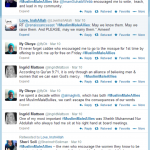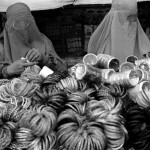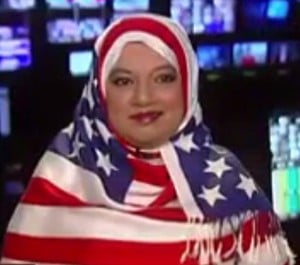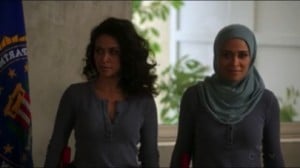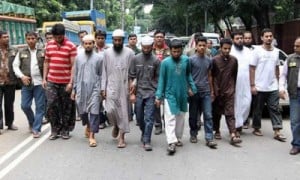Crossposted from Tumblr.
I have been sent @DivineDavis’ recent popular tweet – complete with the hashtag #letsamahplay – many, many times. It involves a girls’ soccer team and hijab used in protest of an unfair rule. My family and friends thought I might have missed it. Perhaps they thought I might be excited by it. Or grateful.
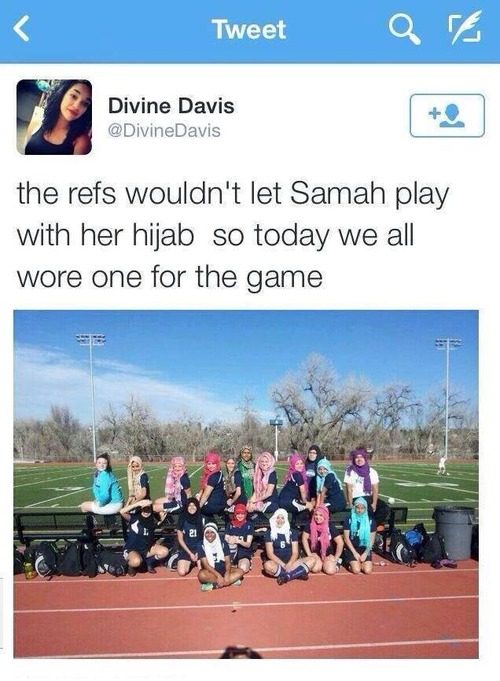
Because the hashtag implied the all-important issue of a woman not being allowed to play, I was interested.
But, I was perplexed. I had about 500 questions.
Why did this team need to adorn themselves in hijab?
Didn’t IFAB (FIFA’s governing body) just publicly declare that women in hijab were permitted to participate at the highest levels?
Wasn’t that a clear enough indication that no official should ban a headcover-clad woman from play?
Where was this?
Was her hijab (with pins, or too flowy) the problem?
Was it Samah’s idea?
Most importantly: DID SAMAH PLAY?
While thinking about writing this piece, it occurred to me for a moment that I might be branded an ungrateful, cynical woman. That has never stopped me before.
The optics of this picture seemed to enamour the world. That tweet was sprinting across Tumblr, through the Twitterverse, and plastered all over Facebook with more vigor than a brilliant Grumpy Cat meme.
I got in touch with Divine Davis and immediately pressed her on the questions I felt needed to be asked. As much as I respected the team’s position to support their friend and teammate, this picture made me terribly uncomfortable.
I realize that 140 characters is not enough space to tell a proper story, unless you are Teju Cole.
Divine’s tweet was short and thus began the hashtag #letsamahplay…. and that hastag was left behind in the dust of a picture that garnered more attention than the actual problem: the exclusion of a Muslimah soccer player.
The optics of a squad of healthy young women of various backgrounds in Colorado, all wearing hijab to support a teammate who was discriminated against, are very powerful.
They stood with her in solidarity. They wanted the local officials to know they were not happy with Samah’s exclusion. Their bright faces were draped in differently styled fabrics.
But there are A LOT more details that render this story less fabulous. And less black-and-white. And in my opinion there are two major issues of concern.
Firstly, Samah was initially banned from playing on March 12th during an after-school varsity game.
Immediately after this game, the school was informed of Samah’s ban by the team coach, and they put in an application for accommodation to her uniform to the Colorado High School Athletic Association (CSHAA). That request was granted immediately. And Samah played the next day on March 13, 2014.
But the team decided the initial decision was unfair, as this is Samah’s last year at Overland High School in Aurora, a suburb of Denver. Samah is a senior athlete, and the pride and privilege that is carried with being a high school senior is important in sports. So, the next game (March 13th) the team decided to take action. They all wore hijabs and posed for a team picture.
Divine’s tweet, which included the statement – “wore one for the game” – implied they played the game while wearing the headscarves, which was not actually the case. The team did not wear their hijabs for the duration of the match. I clarified it with Divine and they wore them for the warm-up and took them off after the photograph. Understandably tweets are limited in the information they can provide. But I felt that clarifying this point was important.
I spoke with Bud Ozello, the State Administrator in charge of soccer at CSHAA. He told me that the CHSAA was aware of the new FIFA rule but had not yet implemented it. They follow the National Federation of High School (NFHS) board who have not amended their equipment rules. He is hoping that this will be accomplished at their national meeting in summer 2014.
The point being that the referees must abide by the rules that govern the association they are affiliated with, and therefore we need to look at the rules that the referees are following, rather than blaming the individual referee for the calls they make.
Even if the highest governing body decrees that hijabs are permitted (which they did on March 1st) local organizations cannot follow suit until their governing associations change their laws, which many have not done. I think that laws are outdated and discriminatory, but it is easy to blame a referee and ignore the larger context.
In my career (spanning three decades), I have been ejected and not allowed to play more times than I care to count. I have been frustrated and angry. I have also been apologized to privately by many officials who tell me their hands are tied until respective associations change their rules.
Instead of penalising a referee, why don’t we redirect energy to lobbying proper authorities?
As we cheer and celebrate victories for Headcovered Women in Sports, we must realize that this is still a long journey. Essentially, a woman in hijab can play for the United States National Squad (the United States Soccer Federation follows FIFA) but can’t play for her local high school team. *Yes, insert #hijabdesk*
The momentum needs to be kept up to pressure local, regional athletic associations on this matter. Perhaps if we give this the same attention that @DivineDavis’ picture received, no more Samahs will be ejected from the pitch.
Secondly, my biggest concern was the way in which the picture was industriously circulated with little attention to Samah’s playing.
Perhaps the simple act of supporting their teammate was enough as an act of respectful interfaith goodwill and the model of loyal sportswomanship.
But very few have heard from Samah herself.
Samah has been contacted many times (via different media outlets) and she did not reply to any requests. Perhaps she is overwhelmed. Perhaps she just wants to get over this. Perhaps she just wants to play. Being made a campaign-girl for social justice isn’t everyone’s cup of chai.
The information I received was from her teammate and the school. I was informed that the idea to don hijabs was not Samah’s idea; it was the “team’s.” They removed them quickly because they were not intending to play with them on. It would have required them to sign waivers stating they wear them due to religious belief. And they would have had to miss a game – like Samah.
I have written about hijab appropriation before. Truthfully, I cringed when I saw the picture.
I applaud these young women for trying to do something. I am not convinced that it is the most efficient way to proceed. Perhaps withdrawing from the match altogether as did the team of Asmahan Mansour when she was ejected from a game in 2007 because of her hijab is a better stance. It is a firm rejection of the exclusion. To have the team and their families write the NFHS is a good start. An online campaign maybe? A tweet to CHSAA or NFHS? A phone call? A story with local paper on this issue?
To wear a scarf, take a picture, then rip it off and continue to play is not quite packing the punch of solidarity.
Divine’s tweet was not even addressed to the CHSAA (which, incidentally, has a Twitter account).
Perhaps drawing attention to this issue might press the NFHS to change their laws. When I contacted them, not a single journalist or private individual request had been made regarding this issue.
It is not enough to circulate a picture and laud it as being “amazing” and “inspiring.”
What is actually amazing is if the public makes queries, asks questions, writes letters that are effective.
The visuals are stunning indeed. They give us warm fuzzies. Did as many people inquire whether Samah played? Not really. Because the picture was enough to satiate a public thirsty for glorious teamwork and niceties.
This is the part of the story that gets boring and gets grey. The part that isn’t a flashy picture of beautiful, strong young women. The part that requires effort beyond a simple retweet. The part that involves caring and time on an issue of inclusion and fair participation.
Divine’s picture was covered by various media outlets and was shared among thousands of people across the world. Divine’s tweet about equality has attracted a lot of attention. Wouldn’t it be incredible if similar action towards Samah’s plight (and other young Muslim women in the United States) was also taken?
Then instead of congratulating those standing in solidarity with her, Samah can compete and not be humiliated.
Divine and the rest of the Overland team have been receiving compliments on their initiative. How many have reached out to Samah? Remember her?
Don’t get me wrong; much respect to a team for acknowledging that their teammate was excluded. But it would have even been more powerful to hear Samah’s voice which is missing.
While Divine’s tweet is shouting volumes about equality, what is the reaction to it saying about activism?
Perhaps one day, players like Samah can participate instead of sitting on the bench until a formal request is issued on her behalf by her school.
Maybe one day we can do without having to post a team picture of non-Muslim women in hijab for a few minutes or so.
Maybe she can just play.

